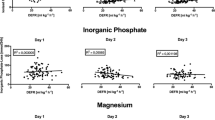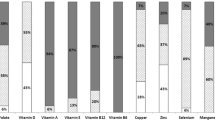Abstract
Purpose
We hypothesized continuous veno-venous hemodialysis (CVVHD) amino acid, trace metals and folate clearance impacts nutrient balance.
Methods
Critically ill children receiving CVVHD were studied prospectively for 5 days. Blood concentrations (amino acids, copper, zinc, manganese, chromium, selenium and folate) were measured at CVVHD initiation, and Days 2 and 5. CVVHD clearance, losses and nutrient balances were calculated on Days 2 and 5.
Results
We studied 15 children aged 7.7 ± 6.7 years. Nitrogen balance was negative on Days 2 and 5. Amino acid clearances ranged from 2.8 to 51.1 ml/min per 1.73 m2. CVVHD losses corresponded to 20% of intake. Days 2 and 5 balances were negative for selenium, but positive for other trace metals. Folate clearance was 16 ml/min per 1.73 m2 on Days 2 and 5 and serum concentrations decreased significantly from initiation to Day 5 (P < 0.05).
Conclusions
Nutrient losses by CVHHD may impact adequate nutrition provision.

Similar content being viewed by others
References
Argaman Z, Young VR, Noviski N, Castillo-Rosas L, Lu XM, Zurakowski D, Cooper M, Davison C, Tharakan JF, Ajami A, Castillo L (2003) Arginine and nitric oxide metabolism in critically ill septic pediatric patients. Crit Care Med 31:591–597
Druml W (1998) Protein metabolism in acute renal failure. Miner Electrolyte Metab 24:47–54
Franz M, Horl WH (1997) Protein catabolism in acute renal failure. Miner Electrolyte Metab 23:189–193
Lyons J, Rauh-Pfeiffer A, Ming-Yu Y, Lu XM, Zurakowski D, Curley M, Collier S, Duggan C, Nurko S, Thompson J, Ajami A, Borgonha S, Young VR, Castillo L (2001) Cysteine metabolism and whole blood glutathione synthesis in septic pediatric patients. Crit Care Med 29:870–877
Kuttnig M, Zobel G, Ring E, Grubbauer HM, Kurz R (1991) Nitrogen and amino acid balance during total parenteral nutrition and continuous arteriovenous hemofiltration in critically ill anuric children. Child Nephrol Urol 11:74–78
Maxvold NJ, Smoyer WE, Custer JR, Bunchman TE (2000) Amino acid loss and nitrogen balance in critically ill children with acute renal failure: a prospective comparison between classic hemofiltration and hemofiltration with dialysis. Crit Care Med 28:1161–1165
Berg A, Norberg A, Martling CR, Gamrin L, Rooyackers O, Wernerman J (2007) Glutamine kinetics during intravenous glutamine supplementation in ICU patients on continuous renal replacement therapy. Intensive Care Med 33:660–666
Zappitelli M, Castillo L, Coss-Bu J, Naipaul A, Juarez M, Jefferson J, Goldstein SL (2006) Continuous veno-venous hemodialysis leads to amino acid, trace element, and folate clearance in critically ill children. J Am Soc Nephrol 17:767A
Berger MM, Shenkin A, Revelly JP, Roberts E, Cayeux MC, Baines M, Chiolero RL (2004) Copper, selenium, zinc, and thiamine balances during continuous venovenous hemodiafiltration in critically ill patients. Am J Clin Nutr 80:410–416
Churchwell MD, Pasko DA, Btaiche IF, Jain JC, Mueller BA (2007) Trace element removal during in vitro and in vivo continuous haemodialysis. Nephrol Dial Transplant 22:2970–2977
Klein CJ, Moser-Veillon PB, Schweitzer A, Douglass LW, Reynolds HN, Patterson KY, Veillon C (2002) Magnesium, calcium, zinc, and nitrogen loss in trauma patients during continuous renal replacement therapy. JPEN J Parenter Enteral Nutr 26:77–92; discussion 92–73
Goldstein SL (2003) Overview of pediatric renal replacement therapy in acute renal failure. Artif Organs 27:781–785
Warady BA, Bunchman T (2000) Dialysis therapy for children with acute renal failure: survey results. Pediatr Nephrol 15:11–13
Bunchman TE, Maxvold NJ, Brophy PD (2003) Pediatric convective hemofiltration: Normocarb replacement fluid and citrate anticoagulation. Am J Kidney Dis 42:1248–1252
Pollack MM, Ruttimann UE, Getson PR (1988) Pediatric risk of mortality (PRISM) score. Crit Care Med 16:1110–1116
Macias WL, Alaka KJ, Murphy MH, Miller ME, Clark WR, Mueller BA (1996) Impact of the nutritional regimen on protein catabolism and nitrogen balance in patients with acute renal failure. JPEN J Parenter Enteral Nutr 20:56–62
Coss-Bu JA, Jefferson LS, Walding D, David Y, Smith EO, Klish WJ (1998) Resting energy expenditure and nitrogen balance in critically ill pediatric patients on mechanical ventilation. Nutrition 14:649–652
Caldwell MD, Kennedy-Caldwell C (1981) Normal nutritional requirements. Surg Clin North Am 61:489–507
King-Brink M, Sebranek JG (1993) Combustion method for determination of crude protein in meat and meat products: collaborative study. J AOAC Int 76:787–793
Bornhorst JA, Hunt JW, Urry FM, McMillin GA (2005) Comparison of sample preservation methods for clinical trace element analysis by inductively coupled plasma mass spectrometry. Am J Clin Pathol 123:578–583
Davies SP, Reaveley DA, Brown EA, Kox WJ (1991) Amino acid clearances and daily losses in patients with acute renal failure treated by continuous arteriovenous hemodialysis. Crit Care Med 19:1510–1515
Frankenfield DC, Badellino MM, Reynolds HN, Wiles CEIII, Siegel JH, Goodarzi S (1993) Amino acid loss and plasma concentration during continuous hemodiafiltration. JPEN J Parenter Enteral Nutr 17:551–561
Novak I, Sramek V, Pittrova H, Rusavy P, Lacigova S, Eiselt M, Kohoutkova L, Vesela E, Opatrny K Jr (1997) Glutamine and other amino acid losses during continuous venovenous hemodiafiltration. Artif Organs 21:359–363
Scheinkestel CD, Adams F, Mahony L, Bailey M, Davies AR, Nyulasi I, Tuxen DV (2003) Impact of increasing parenteral protein loads on amino acid levels and balance in critically ill anuric patients on continuous renal replacement therapy. Nutrition 19:733–740
Wooley JA, Btaiche IF, Good KL (2005) Metabolic and nutritional aspects of acute renal failure in critically ill patients requiring continuous renal replacement therapy. Nutr Clin Pract 20:176–191
Berger MM, Shenkin A (2006) Update on clinical micronutrient supplementation studies in the critically ill. Curr Opin Clin Nutr Metab Care 9:711–716
Nakamura AT, Btaiche IF, Pasko DA, Jain JC, Mueller BA (2004) In vitro clearance of trace elements via continuous renal replacement therapy. J Ren Nutr 14:214–219
Story DA, Ronco C, Bellomo R (1999) Trace element and vitamin concentrations and losses in critically ill patients treated with continuous venovenous hemofiltration. Crit Care Med 27:220–223
Fortin MC, Amyot SL, Geadah D, Leblanc M (1999) Serum concentrations and clearances of folic acid and pyridoxal-5-phosphate during venovenous continuous renal replacement therapy. Intensive Care Med 25:594–598
Gregory JFIII (2001) Case study: folate bioavailability. J Nutr 131:1376S–1382S
Makoff R (1999) Vitamin replacement therapy in renal failure patients. Miner Electrolyte Metab 25:349–351
Irving SY, Simone SD, Hicks FW, Verger JT (2000) Nutrition for the critically ill child: enteral and parenteral support. AACN Clin Issues 11:541–558; quiz 637–548
Petrillo-Albarano T, Pettignano R, Asfaw M, Easley K (2006) Use of a feeding protocol to improve nutritional support through early, aggressive, enteral nutrition in the pediatric intensive care unit. Pediatr Crit Care Med 7:340–344
Radrizzani D, Bertolini G, Facchini R, Simini B, Bruzzone P, Zanforlin G, Tognoni G, Iapichino G (2006) Early enteral immunonutrition vs. parenteral nutrition in critically ill patients without severe sepsis: a randomized clinical trial. Intensive Care Med 32:1191–1198
Honore PM, Matson JR (2002) Short-term high-volume hemofiltration in sepsis: perhaps the right way is to start with. Crit Care Med 30:1673–1674
Bellomo R, Honore PM, Matson J, Ronco C, Winchester J (2005) Extracorporeal blood treatment (EBT) methods in SIRS/Sepsis. Int J Artif Organs 28:450–458
DiCarlo JV, Alexander SR, Agarwal R, Schiffman JD (2003) Continuous veno-venous hemofiltration may improve survival from acute respiratory distress syndrome after bone marrow transplantation or chemotherapy. J Pediatr Hematol Oncol 25:801–805
Scheinkestel CD, Kar L, Marshall K, Bailey M, Davies A, Nyulasi I, Tuxen DV (2003) Prospective randomized trial to assess caloric and protein needs of critically Ill, anuric, ventilated patients requiring continuous renal replacement therapy. Nutrition 19:909–916
Acknowledgments
We acknowledge Amrita Naipaul for her assistance in data collection and Walter O’Rourke (Dialysis Solutions Inc.) and Lee Ware (Baxter Healthcare) for their financial support. Dr. Zappitelli received a post-doctoral research fellowship award from the Kidney Research Scientist Core and National Training Program to fund his training at the Baylor College of Medicine/Texas Children’s Hospital Acute Care Nephrology Research Fellowship.
Conflict of interest statement
This investigator-initiated project was funded by unrestricted grants from Dialysis Solutions Inc. and Baxter Healthcare.
Author information
Authors and Affiliations
Corresponding author
Appendix
Appendix
See Table 5.
Rights and permissions
About this article
Cite this article
Zappitelli, M., Juarez, M., Castillo, L. et al. Continuous renal replacement therapy amino acid, trace metal and folate clearance in critically ill children. Intensive Care Med 35, 698–706 (2009). https://doi.org/10.1007/s00134-009-1420-9
Received:
Accepted:
Published:
Issue Date:
DOI: https://doi.org/10.1007/s00134-009-1420-9




